My adventure with Helibacon, a helicopter hog-hunting outfitter, begins at 4:15 a.m. with a sharp knock on the front door of the house where I’m staying in Houston, Texas. I make some whiplash arm motions, an effort to pantomime that I’ll be going out through the side door, and exit quietly. Beyond the white picket fence, a black Hummer idles at the curb.
Using the foot rail, I hoist myself up into the vehicle and am whisked off into the swampy darkness, Houston giving way to smaller highways, with only a few white pick-ups for company, reflecting the Hummer’s headlights in the dark.
The driver, Chris Britt, is a Texan by way of the Northwest, with a voice that pitches higher with excitement. He’s a big guy, over six feet tall, with a crew cut. In the yellow interior light of the SUV, I catch his face — small, pleasant features, blue eyes, and a button nose. One of Helibacon’s owners, Chris wears the company uniform: cargo pants and a black jacket with the Texas flag on one arm and the Helibacon logo — a mud-flap girl in camo print reclining against a Texas flag with the shadow of a boar behind her — on the other.
Chris had always wanted to be a fighter pilot, but his eyesight was too poor. He met John Dumont, now a partner and the company’s pilot, in the flight-training course for another hog-hunting company. John was the instructor. The men loved the idea of helicopter hog hunting. It was “too much cool all in one package,” Chris says. Chase Roberts, their weapons specialist, worked there too. When the man who ran the place “ended up being a shyster,” the three set out on their own, with Chris providing the financial backing. Helibacon delivered its first hunt in 2013, and now runs about 200 to 250 hunts a year. It’s springtime in Texas, 2015, and I’ve been invited to embark on one of them.

Helibacon and about a hundred other helicopter hog-hunting companies exist in Texas thanks to Sid Miller, a rancher, rodeo competitor, and the state’s agriculture commissioner. A politician of the performative variety, his first public act as agriculture commissioner was to stand at a podium and take a bite of a cupcake, granting “amnesty” to the dessert and sending a clear message to Texas parents that the state was not infringing on their rights to bring sweets to school for special occasions (even though some school districts had chosen to ban them). Then there was a scandal about his expenses. Miller had been accused of billing Texas taxpayers for a trip to Oklahoma to receive something called a “Jesus shot,” which supposedly improves your health forever, but prosecutors didn’t end up having enough evidence to bring criminal charges against him.
Miller served in the Texas House before losing his seat in 2013 in a Republican runoff. While in the House, he wrote and passed House Bill 716, nicknamed the Pork Chopper. Texas is overrun with feral pigs — an invasive species that wreaks havoc on working landscapes. The state’s feral pig population is estimated at about 2.6 million, more than any other state in our fine union, with all but one of Texas’ 254 counties reporting pigs. HB 716 allows landowners to make a deal with hunting outfitters, who sell helicopter hunts to paying customers and thereby help the landowners get rid of pigs.
Helicopter hunting has long been used to effectively cull out-of-control populations of pigs, wolves, and other invasive species on state lands. But in Texas, the largest state in the Lower 48, with over 95 percent private land, individual owners needed a way to control the pig populations inside their fences.
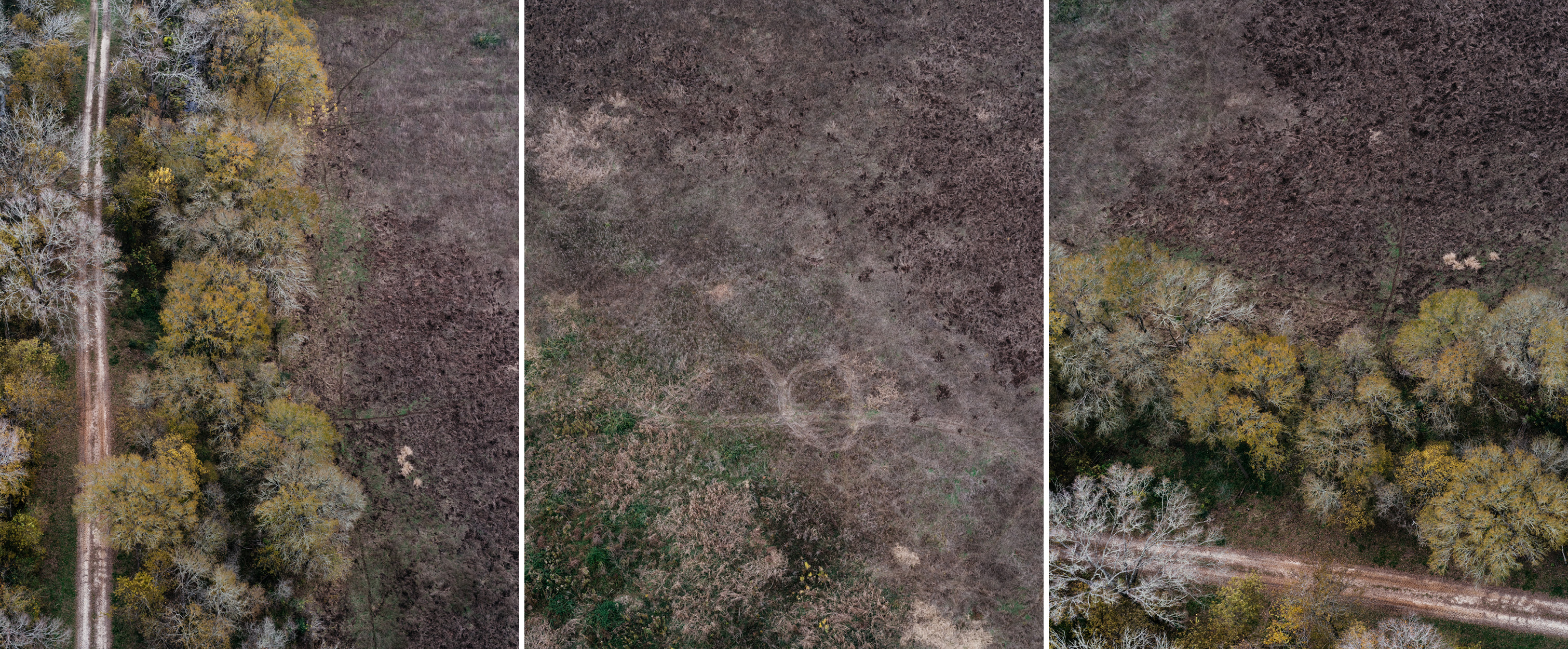
Miller greets me warmly, asks me how I’m enjoying Texas. His wood-paneled office is huge. I am easily the smallest thing in the room, dwarfed by cowhide chairs and a mounted Indian headdress. His desk, about the size of a Cadillac, has a sign affixed to it: pray, it’s not illegal yet.
Miller got the idea for the Pork Chopper after dealing with a persistent hog problem on his own ranch. “They just kept getting away from us,” he says. “We would trap them, and have people come in and hunt them with dogs. We weren’t making any headway.” Helicopter hunting is a very effective form of hog removal, and he knew at the time that individual farmers were pooling together with their neighbors and getting aerial wildlife-management permits from Texas Parks & Wildlife, and then hiring pilots and gunners to come depopulate their land for $500-plus per hour. But what if, instead of paying someone to come and kill the pigs, the landowners could grant permission to the hunting outfitters, whose paying customers would do the hog removal for them? What if you could solve this problem with the most American tools at our disposal: guns and the free market? “What we ended up doing was taking the liability from the farmer and rancher and turning it into an asset.” This also provides tourism where there was none before — “heads in the beds” at motels.
Miller says the Pork Chopper “was all anyone could talk about” when he passed it. “I didn’t think a lot about it,” he says. “I passed a lot of bills that I would think are equally important or much more important.” Besides HB 716, Miller’s other well-known piece of legislation that session was the now-infamous Texas law requiring sonograms before abortions.
Through his work on pig elimination, he met Ted Nugent, musician and National Rifle Association spokesman. Nugent was very involved in Miller’s campaign for agriculture commissioner. Miller says they exchange emails and texts, and spend time together at Nugent’s place near Waco and his hunting lease at Carrizo Springs. Nugent’s a bit busy to hang with the commissioner though. “He probably has less time than I do. He tours three months of the year and hunts the other nine months.”
Miller was forward-thinking. Helicopter hog hunting is now legal in North Carolina and Virginia, though only if wildlife officers are doing the gunning. Georgia has eliminated most restrictions on when and how you can hunt hogs. But Texas is still the only state where recreational hunters can pay to be in the air and behind the trigger.
“It’s something you think that, if it happened, it would probably happen in Texas, you know,” Miller says. He laughs. “There’s kind of something special about being a Texan. It’s hard to describe, but you know it when you see it, and this is one of those things.”
As I get up to leave, I compliment him on his office. “I think this is the way all offices look in Texas,” he says.

Chris is good company during the car ride to the hunt site: He has a public relations man’s eagerness to please, mixed with the detail-oriented argumentativeness usually reserved for legal scholars or religious fanatics. He apologizes for the Hummer’s back window, which is stuck in the open position. Usually he would take his wife’s BMW, especially for the miles per gallon on the 100 miles to the hunt site, but she’s using it today. He parks in the spot for fuel-efficient vehicles no matter what he’s driving, because the government can’t really tell him the most efficient car to do his job.
In the wake of the Pork Chopper, there are plenty of newly minted hog-hunting outfitters in Texas, each one differentiated by how they market their services, and to whom. Helibacon appeals to the corporate customer: fancy uniforms, detailed safety course, and thorough branding, down to the shiny Helibacon guns. Helibacon has an FFL, or federal firearms license, so they can manufacture their own guns and automatic weapons. The company uses AR-15s, a lightweight magazine-fed semi-automatic weapon that allows for quick, continuous fire. Gun-safety advocates call the AR-15 the mass shooter’s weapon of choice, used in Orlando, Aurora, and Sandy Hook. AR-15s were outlawed under the federal assault weapons ban that was passed in 1994 but expired in 2004, and they are still illegal in some states. Proponents say that the AR-15 is an important hunting weapon, and that helicopter hunting is the ideal use for this semi-automatic assault rifle.
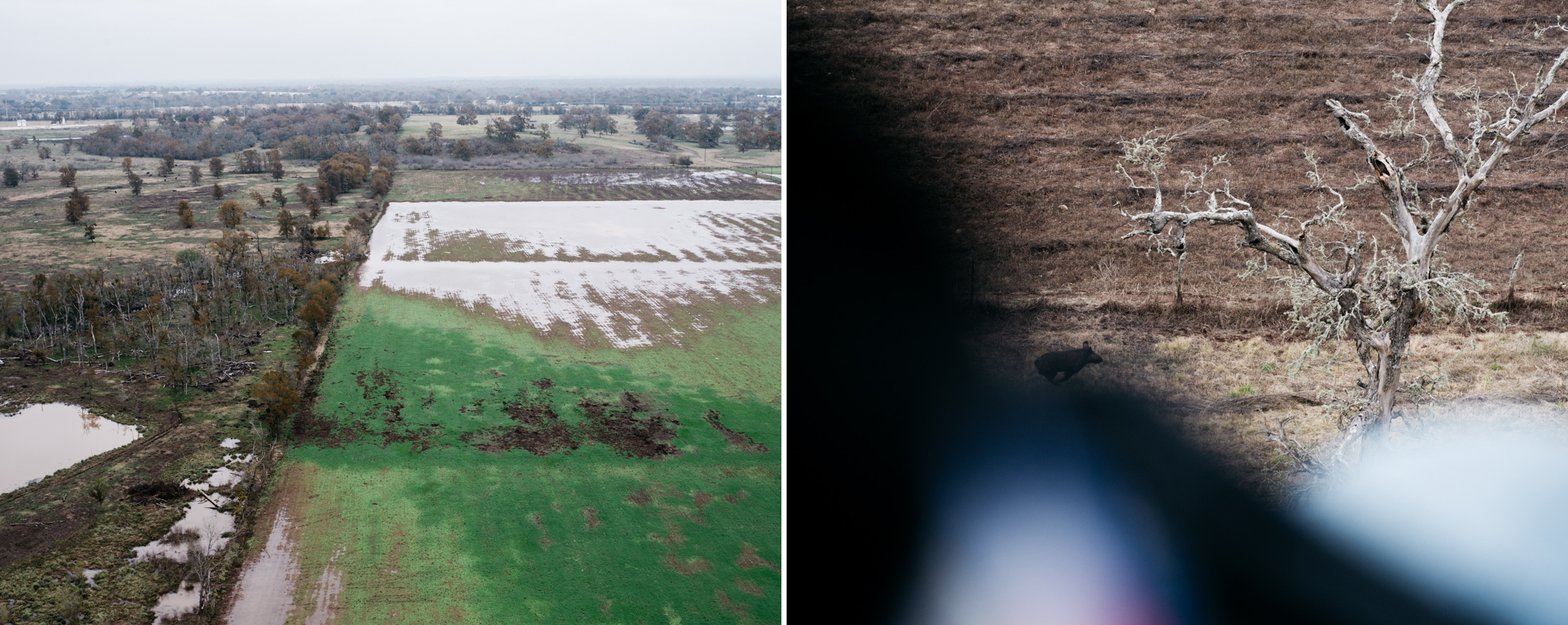
Being located near Houston allows Helibacon to pick up people in town on business and oil-rig workers who have saved up vacation after 37 days in the field. Unlike many outfitters, they advertise abroad; international business makes up about 30 percent of their clients.
“Aviation as an industry doesn’t understand how to sell and package this particular type of activity,” Chris says. Many outfitters target individual hunters and ex-military guys, who almost never have $3,500 for a two-hour hunt (the going rate at Helibacon) or the extra $400 per customer to upgrade to machine guns and shoot pigs with full auto.
He tells the true hunters — the “bloodthirsty rednecks” — from the corporate clients by the questions they ask over the phone. “Hunters ask, ‘Do I get to keep the meat, is it harvested, am I guaranteed a kill, is it cheaper if I bring my own ammo?’ They nickel-and-dime you. The corporate client asks, ‘What days are available, what amenities do you have?’” His clients understand that they are killing pigs because pigs are bad for the environment, but this isn’t a huge incentive.
The helicopter is expensive to maintain, and Helibacon pays a lot for insurance (“like we opened a preschool next to a volcano”). But the biggest limit to their business is access to good land. Texas has millions of acres of private land with feral hogs roaming it. But to allow for a good hunt, the land has to have easy access to the hogs, which means food that lures them there, and large open areas in which to shoot them from the air. Helibacon has to turn down requests from landowners on account of nearby roads, schools, and parks. They seek out landowners with nice juicy tracts they want to use, but the sweet-talking doesn’t always work.
“So you are a rural landowner, and these 78,000 acres have been in your family,” Chris explains. “Now some city boys that bought themselves a helicopter want to come play on your property, and that sounds dangerous.” He puts on a deep twang for the last bit: “And we got Betsy’s cattle out here…. I don’t know about that.”

Pigs came to the New World with the conquistadors. They were indispensable to explorers; you could leave a few pigs on an island, and when you returned they would be everywhere, fat and ready for slaughter. The word buccaneer comes from the French boucan, for smoked meat, and boucanier, for the hunter who smokes it. In 1539, the Spaniard Hernando De Soto landed at Tampa Bay, bringing 13 pigs to the United States mainland. In 1542, his expedition brought hundreds of pigs to the land that eventually would become Tejas.
Domesticated pigs would escape from farms, or be set free in hard times. Some early colonies, like New York, kept their pigs feral, or semi-domesticated, in large herds. The “wall” in Wall Street originated from a fence built in part to keep these feral pigs from rooting in nearby orchards.
Starting in the 1890s, millionaires craving an Old World hunting experience (at New World prices!) supplemented the stock of feral pigs in the U.S. with Eurasian wild boars. These animals interbred. As a result, feral pigs in the U.S. range from pink, cuddly looking things to animals with large tusks and ears and a ridged back — something you might run from in terror.
For much of the 20th century, the feral pig population in the U.S. remained steady. In the 20 or so states they inhabited, they seemed to fit in, an invasive seemingly turned native. But, in the 1970s, game wardens and hunters started seeing the animals’ potential. They gave pigs game status. Pigs were assigned hunting seasons, bag limits, and were actively stocked, which increased the population in states including North Carolina, Florida, Mississippi, California, and West Virginia. While hunting seems, on its face, to be a way of reducing a population, it is “a double-edged sword,” says Jack Mayer, a research scientist and manager at the Savannah River National Laboratory. Mayer, who is a world-renowned expert on pigs, came to the subject because he loved hunting them.
Over time, people began to illegally stock pigs to hunt, introducing them to new places. “A lot of people that didn’t want to drive south very quickly figured out this was something they could fix,” Mayer tells me over the phone. “This was completely illegal, but it stopped very few people. As usual, we did this to ourselves.”
As a result of illegal stocking, the 20 states reporting wild pig populations at the end of the 20th century jumped to 47 states today — everywhere except Wyoming, Delaware, and Rhode Island. Thirty-six states have established populations, which means they have a serious problem. The national wild pig population is estimated to be between six and eight million. For reference, the population of New York City is 8.5 million.
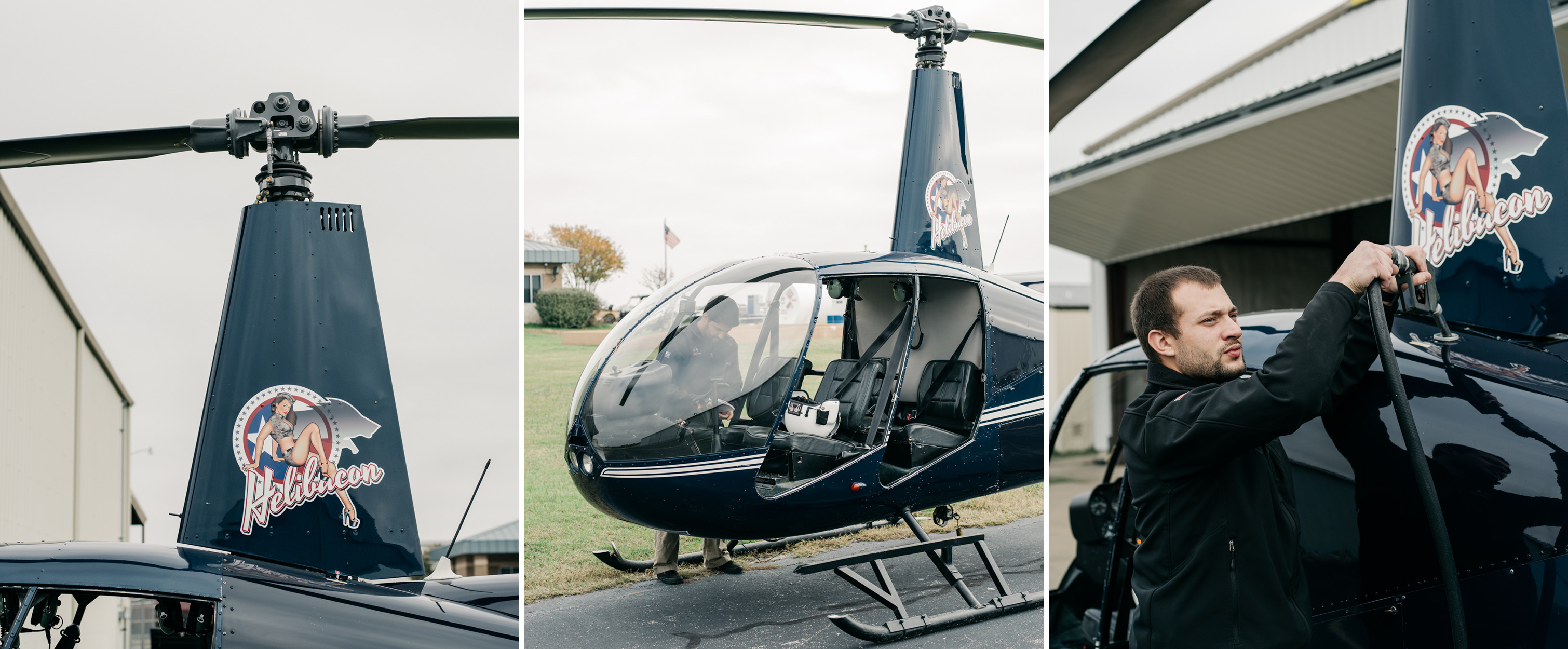
Mayer says he first noticed the numbers ticking up back in the ’70s, but he didn’t expect such a boom. When the growth ramped up, “we started running around like Chicken Little, going ‘the pigs are coming, the pigs are coming!’” People would say: “What pigs? Are you kidding me?” They figured pigs would be as easy to control as deer. There are a lot of deer, but hunting can be effective at keeping populations down.
Pigs are much smarter than deer. They can learn to avoid traps, and can change their behavior, even becoming nocturnal to avoid hunters. They can live almost anywhere in North America, from the Canadian tundra to the swamps of the Southeast. Like us, they are omnivores. They will eat seeds, eggs, acorns, plants, snakes, and turtles — basically anything. They could conceivably eat humans too, if they developed a taste for us. Which seems fitting, given how much we worship at the altar of bacon (“pray, it’s not illegal yet”). People, especially those in the pig-killing business, are quick to note that pigs even eat their own dead.
Most feral hog damage comes from “rooting behavior.” Pigs have an excellent sense of smell. They sniff out seeds and grubs under the soil and then shove their snouts down into it to reach them, creating a furrow. No native species do this except the armadillo, but its range is comparatively small.
The pig has few predators, and the highest reproductive rate of any large mammal. There’s a saying that they are “born pregnant,” and it isn’t far from the truth. They can start reproducing at 13 months, some as early as eight months. Sows have five to six pigs per litter and approximately two litters every three years. The litters are bigger when the pigs are well fed. And wild pigs don’t just eat wild foods. Add to the list of this omnivore’s delights the nutritional value of food crops such as corn, grain sorghum, pecans, peaches, and rice, the corn left out to attract pigs in areas where they are stocked, add the 300 million pounds of corn and 100 million pounds of protein used for deer hunting every year, and that’s a lot of piglets.
Experts estimate that pigs do about $1.5 billion of damage a year in the U.S. Texas deals with at least $50 million per year in agricultural losses alone. It’s “an interesting intellectual problem,” says Evan Siemann, an ecologist at Rice University. “What happens when you have a novel type of rooting omnivore that’s invasive?”
Siemann launched a multi-year study in 2001, in which he fenced pigs out of eight 10-by-10-meter plots and left eight others open in the Big Thicket, a national preserve in southeast Texas, then measured the differences between where the pigs were and weren’t. He found what he expected to find. Pigs churn leaf litter, which accelerates the decomposition process, creating a more habitable environment for invasive plants. They uproot understory plants and eat “big delicious seeds, like acorns and hickory,” reducing the abundance of large trees and making room for invasive species like Chinese tallow. This creates a broken system where new canopy plants don’t grow.
When I ask Siemann to put the problem in context, he tells me that that there are invasive plants that do more harm than pigs, but they are much less of a public-relations nightmare because people feel less sympathy for plants, and they are also much easier to kill. Siemann is a vegetarian. But as I leave his office he tells me, with resolve, “If I were a good ecologist I would shoot every feral hog I see.”
The frontiersmen who crossed the Appalachian Mountains and settled Texas fought the land to make their homes and build their republic. They fought the Mexicans and the Indians, war on both sides, the great wild beyond. They fought for every fort gained, every landscape bludgeoned into submission. “Texas patriotism was never based on concepts of government or on ideas,” writes historian T.R. Fehrenbach in Lone Star: A History of Texas and the Texans. “It grew out of the terrible struggle for the land…. The Texan’s attitudes, his inherent chauvinism and the seeds of his belligerence sprouted from his conscious effort to take and hold his land.”
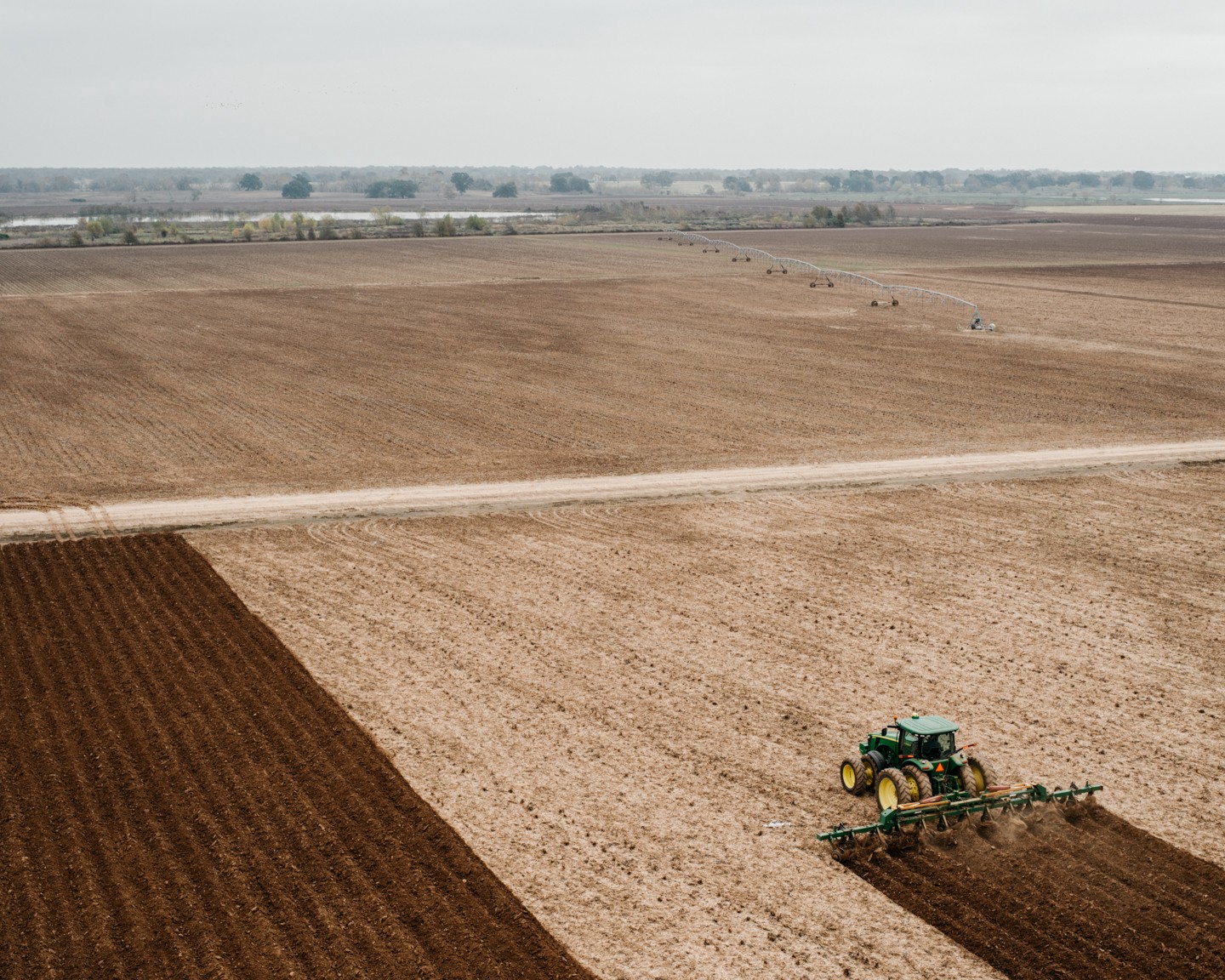
(Photo: Benjamin Rasmussen)
The pigs are rapidly undoing the civilization Texas has imposed on its wilderness — a cemetery in Troup, Texas, dug up overnight, as if the people interred there decided to set themselves free. Texans are seeing shredded crops, golf courses, medians, football fields. They are calling Miller on the phone to tell him about it. They are craving a war.
Meanwhile, we damage the landscape just fine all on our own. Development is still the biggest threat to coastal prairies, Siemann says. “If you have a prairie that has a lot of feral hog damage, that’s a whole lot better than a subdivision.”
To keep the Texas hog population steady, experts estimate we’d have to remove around 70 percent every year (current figures have landowners removing about 24 percent, but this number could be pretty far off, because we don’t know how many pigs are actually out there). Think of this 70 percent, or roughly 1.8 million Texas pigs, measured in units of hog killing. A hunter in a blind picks off one or two. Hunters using dogs to bay pigs pin down and kill one at a time. A night-vision hunt might bag around seven or so in the dark. Trapping allows for bigger hauls, sometimes a wholesounder (family unit, about 25 pigs). But pigs are smart and will learn to avoid traps if they see other pigs stuck in them. New traps have cameras that are monitored by iPhone, and only close when the whole sounder is in. A chemical that is lethal to pigs (made, ironically, of sodium nitrite,which is used to cure bacon) is deep in the U.S. Department of Agriculture approval process, but likely won’t reach the market for a few years. When the pigs eat it, they are supposed to lie down, go to sleep, and never wake up. It has shown promise in a study at the Kerr Wildlife Management Area in the Texas Hill Country. Some scientists in Louisiana are working on a night-vision pig-killing drone. But, for the moment, the most effective way of hunting hogs is by helicopter. If the landscape is open, a trained shooter can kill 70 in a day.

As we cruise along in the Hummer, Chris shatters some illusions about the cozy relationship between landowners and customers. “The first couple of months [on a property] the hunting is very productive,” he says. “We’re killing 25 to 40 pigs a hunt, then a dozen, then six, then two. The customer is out paying a lot of money and only saw two to shoot. Meanwhile, the landowner is thrilled, but yeah, well, my customers want a refund. Landowners want me to fly seven days a week and twice on Sundays, but my customers tell me, ‘I want to hunt on a place you haven’t hunted in a month.’”
While the state clearly has more than its share of hogs, for Helibacon, oddly enough, not having enough pigs to shoot has become a problem. Chris wants to expand the business in other directions, offering days of sport-shooting at targets from the air, explosives, guns mounted to the helicopter doors, boxed lunches, tourism. When he met with angel investors in New York City about this a few years ago, he was surprised at how tepid the reaction was.
“On the East Coast there’s a lot of ignorant fear. I’m not saying people are stupid. They just don’t know. People say, ‘Oh, I’m so afraid of the gun.’ A gun itself is not going to wander off and go kill somebody.”
Chris manages the Helibacon Facebook page, which has almost 160,000 likes and has had a very active commenting community. They post videos with kill shots and dead hogs, which attract new business in the hunting community and get the angriest comments. “The truth is, society doesn’t like death.”
The most frequent question both online and in person is, “What happens to the dead hogs?” People hope they are eaten. Regarding the needy, hungry people often referenced in these comments, Chris says, “We certainly invite them to come out to the field and help with the work of recovering and cleaning the feral hogs.”
But this is easier said than done. The locations are remote, the pigs are heavy and difficult to dismember. Some of them carry diseases. Chris told me many customers who have intentions of recovering the meat relent when they find it will cut into their hunting time.

The hip Austin restaurant and butcher shop Dai Due is a hog-friendly business. Chef Jesse Griffiths sells feral-hog chorizo in his butcher case, and puts hogs on the menu anytime he can get them. He teaches courses on how to kill, break down, and cook pigs.
Griffiths told me that pigs have terroir like wine: You can taste the difference in a feral pig from south Texas versus central Texas, and the best ones are the ones you hunt when they are fat on acorns. For his business, Griffiths is required to buy hog meat from a processor that does USDA inspections and kills the animals live. They are trapped and sold to a buying station and trucked to a processing plant where they are shot with a .22, because pig skulls are too thick for the bolt gun. Between 2004 and 2009, only 461,000 wild pigs were USDA inspected at processing plants and sold for eating in the U.S. and for export to Europe (where they like the taste of boar) and Asia (where there’s a pork shortage).
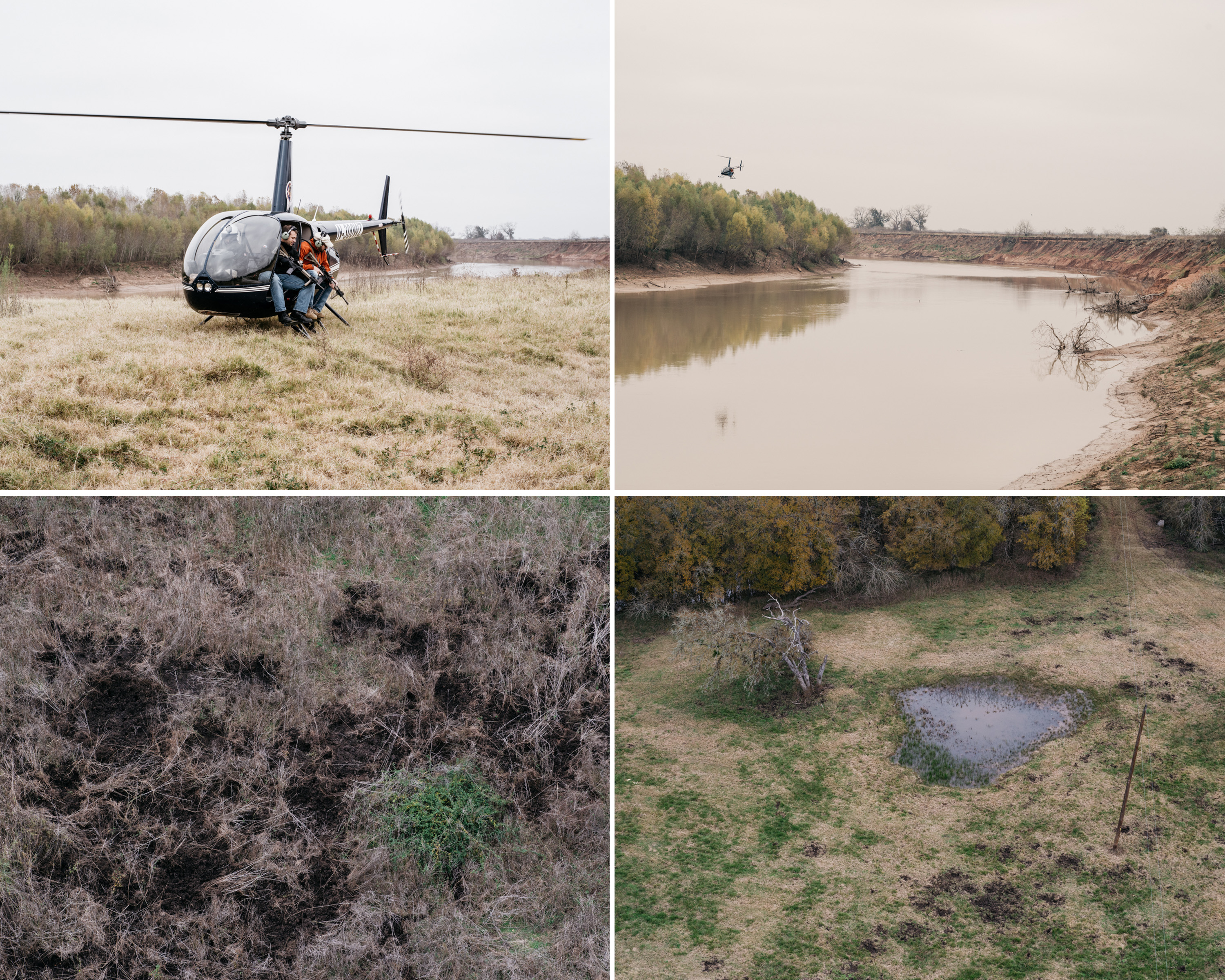
Griffiths never seems to have enough hogs. He can’t take the meat people hunt even though they offer it to him. “I would like to use more but sometimes it’s hard to get,” he says, “which is ironic, because there are so many of them out there.” He is vehemently opposed to helicopter hog hunting, both because the meat is wasted and for moral reasons. “In the case of helicopter hog hunting you are playing a video game with a live animal,” he says. “I’m not believing the altruistic streak people have. It’s like, ‘Oh, I’m doing a bunch of good.’ Go volunteer at a soup kitchen.”
“Trust me, I get it,” Griffiths says. “Every pig I ever see I try to kill. But I also try to eat them. People are shooting 30 a day, and then you have people starving in the same community.”
Dai Due had just gotten hogs in on the day of my visit. I see them laying in chunks on the steel butcher’s table, which looks to be about as big as Commissioner Miller’s desk, and being carefully shorn apart with a giant saw that looks like it was made for cutting down trees. I buy some boar-meat chorizo from the butcher’s case, and it rides around with me for a few days, ensconced in a Ziploc full of ice. When I fry it up, the meat is strong, greasy, and tasty, and it leaves a red trail on the plate. The scent of animals lingers in the kitchen, a dead, savory smell.

At the airport in Bryan, Texas, where Helibacon flights originate, I attend the safety course, which covers basic gun safety and how fat people from Louisiana are. A couple is here for an hour-long hunt they won in a charity auction, which, I’m told, is not enough time for any serious killing.
It is barely mid-morning when they return, having killed no quarry. John Dumont, the pilot, is dying for an omelet, so we head to the Cracker Barrel. While we wait for a table John bops around, tasting free Jelly Belly samples. He offers me some. “They are actually really good,” he says.
We sit in the center of the restaurant, across from a massive hearth. I ask them for customer horror stories. “There are some folks that think they don’t need the safety course, and they are usually the worst ones,” Chris says. “And, actually, Chinese customers, because of the language barrier. And they are not allowed to have any kind of firearms in China, and they have very little experience.” There is a picture on Helibacon’s Facebook page of a group of grinning Chinese folks on the tarmac, with Chinese writing beneath it. Chris’ caption reads: “Hunting hogs from a helicopter with machine guns is unique enough that Helibacon has become a global destination event. Here is a recent picture of some Chinese fellows enjoying the liberty available in Texas.”
When the waitress comes, John orders a blueberry pancake breakfast with scrambled eggs and bacon. Chris, who already ate, asks the waitress for a fruit bowl. “It will be for my gay friend — he’s not here yet,” he jokes. She nods.
They are suspicious that I’m there to perpetuate the idea that hog hunters are bloodthirsty hicks.
“All you need to say is that it’s incredibly controversial,” John says.
“And lots of people are highly offended,” Chris says.
“A lot of people are just uneducated about it, that’s all,” John says.
“We don’t look like a bunch of rednecks,” Chris says. He pauses. “Are you going to eat that bacon,” he asks John, motioning to the dish. “Can I have one?”
“That was a very petite fruit cup,” I say.
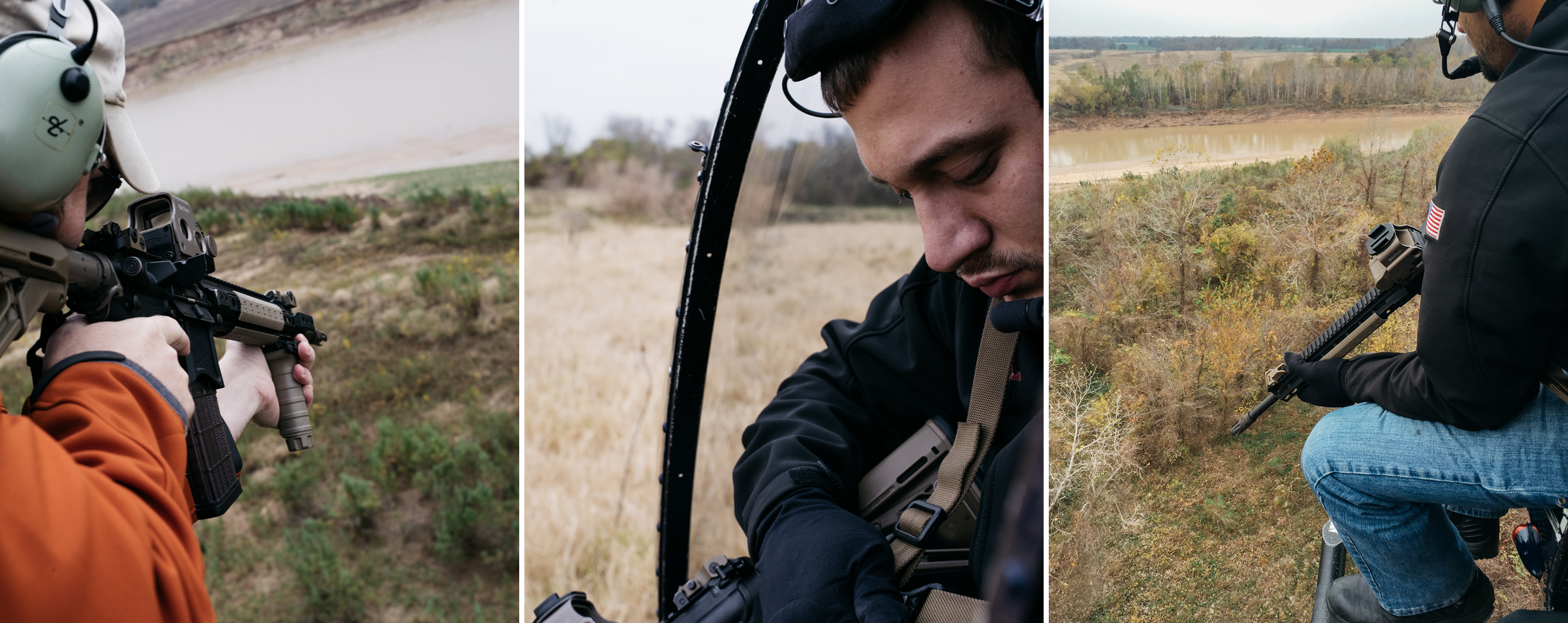
“Opponents of this activity tend to imagine it’s their worst nightmare, it’s crazy and bloodthirsty,” Chris says.
“We shoot a hog and then knife it and lick the blood off,” John says.
“Maybe I’m overly sensitive because I face it all the time,” Chris says. He mimes me writing in my notebook. “Chris Britt is overly sensitive. He ordered a small cup of fruit. It was very petite.”
They ask me what I think of their new business idea to take the company in a more elaborate direction, with explosives, aerial target practice, door-gunned helicopters.
“There’s nowhere else you can have an experience like that unless you are in a war zone,” John says.
“Yeah, but then they shoot back at you,” Chris says.
In the parking lot I approach the Hummer from the rear for the first time in the light of day. Chris’ license plate says: s3cede. The holder says: don’t tread on me.

When he picks me up again in the Hummer the following morning, Chris confesses that he has been worrying over our conversations about how effective Helibacon is. “Honestly, I don’t think we actually had a significant impact on the total population numbers in a county,” he says. “One little guy with a helicopter is not going to do that. My takeaway is that helicopter services can be effective at controlling the hog population in localized areas.”
At the airport, the cloud ceiling is low and dropping as the sun climbs higher. The weather is, in John’s professional opinion, “shitty.” The clients are hanging around the helicopter, which is parked at the fueling station while John juices the tank with 46.5 gallons of gas. The Helibacon boys bought their ride, a Robinson R44, from an aviation company serving the oil and gas industry in Alberta, where it was being used to ferry workers from Calgary to Fort St. John and back. They flew the 22 hours to Texas over three days, crossing over the Rocky Mountains and Yellowstone. “The most beautiful flight,” Chris says.
Once the helicopter arrived in Texas, they got a new number for it, removed the doors, and installed a metal rail on the left side for hunters to rest their legs on while leaning out to shoot, then adorned the shaft with the Helibacon logo.
The older customer, Chad, says hello first. He runs a custom harvest operation, cutting wheat from Vernon, Texas, to the Canadian line. He wears a John Deere jacket; his wife works in the John Deere corporate office, but he says he doesn’t get any deals. Chad’s done a lot of pig hunting, especially before dawn in the fields in Vernon. I ask him how he found Helibacon. He remembers he first saw it on Facebook.
“You said: ‘Man, I saw your video on Facebook. I got to do that!’” John says. Chris adds, “I think you asked if the girl in the video came with the hunt.” Chad offers no confirmation.
The other client, Durby, is so young looking, with his blonde hair and baby face under a trucker’s hat and baggy bright-orange hunting sweatshirt, that I mistake him for Chad’s son. He isn’t. They worked together during the harvest last summer. Durby is from Blackstone, near Richmond, Virginia. He introduces himself, “Durby, like Kentucky Derby,” in a shy Southern murmur. He’s 23 and runs his own trucking company, two trucks and another driver. It’s “my first vacation in quite a while,” he says.
John uses Pledge to clean the plexiglas windscreen. “We’re not just pig murderers, we’re also bug murderers,” he says.
“I’m surprised PETA doesn’t get after that,” Chad says.
Chris and John tell Chad and Durby about their plans to expand their company. Chad gets excited when they talk about getting a Huey with a door gun, a Vietnam-era military helicopter, for both hog hunting and target practice.
“Shit, get it ordered. You could probably get a TIF grant.”
“Yeah, we could get some government money to help us out,” Chris says. But a Huey is expensive: $1,200 an hour just to run it, and the ammo, he says, at 60 cents a round. “The EPA closed down the last lead smelter in the U.S., so now all ammo makers have to import lead from China,” Chris complains.
Chad sympathizes. He had to change batteries in his combines, for “emissions crap.”
Business is getting hard, the men agree, on the tarmac in the spitty rain. For Durby, trucking is getting near impossible. “The law’s getting really bad. All your drivers have to get drug tested, and you gotta be physically fit or take a sleep apnea test. It doesn’t make any sense. It’s bad because people sit in an office and make the rules and never been in an industry.”
After a while the cloud ceiling rises again, and John gives the OK. Chris goes to get the AR-15s and XM193 NATO ammo from the gun safe in the front office.
The helicopter resembles an insect, and when John turns it on, rotor whirring, it seems to come alive. Somewhere in the flatness beyond the concrete of the airport, birds are singing.
Durby slides in up front and Chad sits next to me. They adjust their seatbelts as instructed, removing the diagonal shoulder strap so that when the time comes they can slide their legs out of the helicopter and place them on the rest, leaning out and down for a better shot.
I’m in the back right, a dead seat — because there’s no shooting behind the pilot — extra ammunition magazines next to me.
John takes the chopper straight up. He’s a skillful pilot, and the way it flits around stays in your dreams. John calls it a magic carpet ride.
He radios air traffic control to report his position, radio frequency, and approximate return time, and then we are zooming south at about 145 mph. “It’s kind of funny flying over big towns with guns,” Chad says as we cruise over the smiling crescents of subdivisions, AR-15s nosing out of the left side of the copter.
We slow down to about 30 mph and start looking for pigs. Spring has come to this part of Texas, the oaks are beginning to bud, and the land is a soft sage color. When we push down into the tree line, pollen snows up into the helicopter. Hog damage is in evidence: oozing brown gashes in the earth, curving in odd directions, looking, as John says, “like someone got drunk and used a rototiller.” Vultures crown the almost-bare treetops, the benefactors of a recent hunt.
John gives Chad and Durby permission to load their weapons. There’s a satisfying chink-ching noise as they push the 30-bullet magazines, loaded with 28 bullets so they don’t jam, into the bottoms of the guns. We are just edging over the property line when John says: “I’m going to ask you to slide out. We already have pigs.” He’s hanging out his side to get a better view while piloting the helicopter and monitoring the shooters — three tasks at once, as easy as breathing.
A line of small pigs is running through the sparse woods, dead trees cracking under their feet. There’s a roan one and spotted ones. Some are tan and others black-brown. They are about the size of fat dogs. Their tails hang down and their ears prick up at the sound of the helicopter. John estimates some are as young as three months old. They are running for their lives, fear in every bobbing step. My heart rate quickens too.
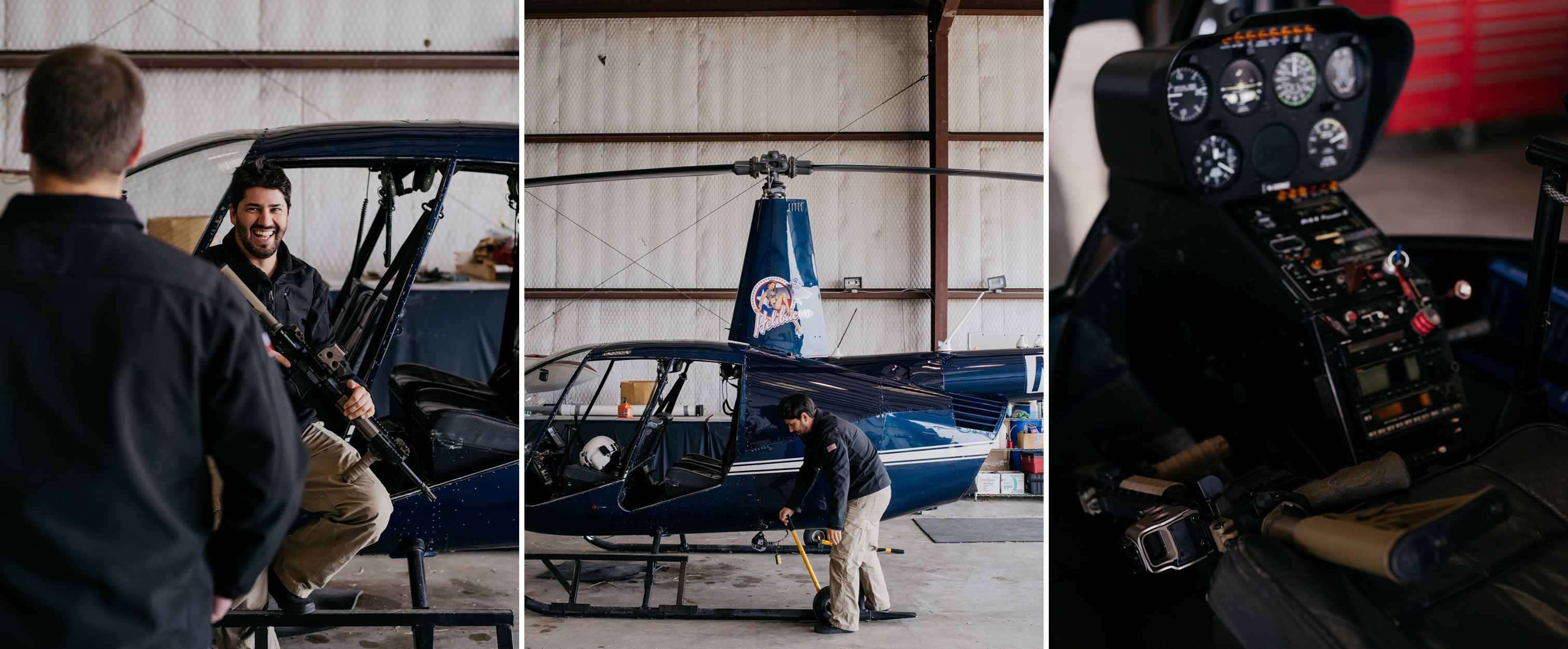
John pushes the aircraft over the pigs, guiding them toward the red collapsed bank of the Brazos River. The far bank is high: He knows the helicopter won’t be able to clear it. As we swing down over the river, John asks me if I’ve ever seen an animal die like this before. I say only my family dog, euthanized the summer before, but it was nothing like this. We dip down, close to the water. He clears Chad and Durby to fire, and they lean farther out, sending sharp pops of semi-automatic fire, about five seconds apart, as they take aim at the pigs’ backs. The air smells strongly, like burning machinery. As the bullets hit, the frantic pigs flip and submerge in the creamy brown water. Blood begins to spread. The men keep shooting until they see no movement, ribbing each other on their misses.
We fly back over the woods and see a coyote, located at 7 o’clock. John is reluctant to go after it. “I’d rather get pigs,” he says.
“I want to get that coyote,” Chad says to Durby, pronouncing it kai-yote.
We see a group of pigs in the middle of the woods, and then lose sight of them. We circle back the other way, flying low over the river. John points out the floaters, no longer living things, just buoys suspended in the moving water. More piglets, running again. John flies down, pushing them toward a strip of land at the river’s edge. Both clients shoot at the same one and the bullets rip through it. The blood and organs spatter on the ground. Death appears instantaneous.
Nine confirmed kills already, and the clients are surprised by how easy this is. Another coyote (or the same one), another miss. It disappears under a log. Another small group of pigs appears. In the rush to shoot them before they run back into the woods, both men have near misses, and shots that maim but don’t kill. John hovers, instructing them to “double-tap that guy.” It’s company policy to try to make sure every pig they shoot is dead. “It’s about not being cruel,” John says. We are watching a pig that’s still twitching, kicking its legs out. “I think it’s just nerves,” he says. Twelve confirmed.
After an hour, we land at the refueling site. Chase, the third partner, has set up a flatbed truck with gas tanks. I hop out, almost forgetting to wait for the thumbs-up all-clear to indicate that the blades have stopped moving. My whole body is thrumming from the wind, cold, and adrenaline. I’m shaking, but I also feel smoothed out and alive, purified, like after a ferry ride on a stormy day.
When Chase refuels, he takes a wide berth around Chad and Durby, still sitting in the chopper. Durby has his gun on his lap as casually as if it were an umbrella, and it’s pointing straight at Chase. Chris points this out to me later: the danger of people so comfortable with guns they forget what they can do.
John takes the clients back up while Chase and Chris offer to take me target shooting. All weekend they have been encouraging me to shoot one of their special Helibacon guns. “A unique opportunity,” Chris kept saying. He wanted me to have fun, and to prove something, I think.
I stand there frozen with the gun. I keep thinking, human error, human error. How much more will we introduce, and what will be the point of no return? We built the subdivisions, brought the pigs. We can’t correct this, even with the environmentalists and farmers and free-market capitalists and right-wing politicians all on the same side. So the bullets are flying, but it is hard to say if any of it will make a difference. Poison isn’t going to be a miracle fix either. “Poison,” chef Griffiths told me. “That’s all you need to say.” The problem is that the problem is actually bigger than the pigs. We are the enemy, and we are fighting ourselves.
A low firework noise comes booming through the trees. Durby and Chad have found pigs again. By the end of their hunt they will have killed 25 pigs and two coyotes — Chad gets his man. They are close to us now. We can hear every shot they take. I am in a full heart-pounding panic, trying to appear calm while asking if there’s any possibility that they might shoot us by accident, but Chase and Chris assure me that we’re safe here. The shots are echoing through the ravine and the woods and the heavy Texas air. The war is on, and it is unwinnable.





